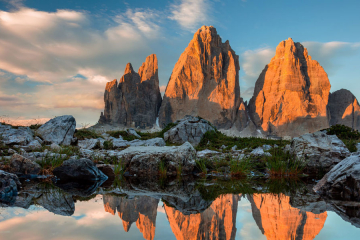There’s an idea I’ve been fascinated for years now. It’s one of those things that has endured through different businesses and phases of my life.
It is the idea that there is a new kind of professional role being formed in society at large – a kind of entrepreneur who is soul driven in some sense. A role where one’s professional work, is not seen as distinct from their spiritual path of awakening. It’s why I called my previous brand The Realized Entrepreneur.
At the end of last year, I started writing about an archetypal way of modelling this character. I suggested that this new professional could be seen as the integration of three intrinsic archetypes – the artist, the merchant and the seeker.
I then suggested the intersection of these was the hero.
Honestly? I’m not convinced I’ve got the mapping quite right. But after a few months exploring some different writing avenues, I’m returning to this map in search of answers. Specifically, a topic that’s gnawed at me for years, that is, how on earth do art and marketing fit together?
Temperamentally, I usually love creating new stuff, and desperately resist marketing it. And I know I’m not the only one that is like this.
Is that because marketing is for shallow schmucks who can’t create interesting enough stuff that people naturally pay attention to? Or is this my precious pretensions restricting me from actually publishing myself?
Can the artist and the merchant work together?
The Artist
The artist is principally concerned with creativity. His objective is to create something original, something that provokes a deeper experience of the world, or elegantly solves the most complex of problems.
Beauty is in the eye of the beholder, and so the artist creates things that they themselves find beautiful. They create to meet their own taste.
They are driven by the creative impulse. And creativity, as Seth Godin so eloquently defines it, is the tension between “this might work” and “this might not work”. If you know it will work, or you know it will not, it’s not creative. If it’s pre-determined it’s not art.
Art is not painting, it is not poetry, it is not design. It is what is created when we venture beyond the border of what we know, and allow the mysterious forces there to guide our hand as we create something that intrigues us. The artist knows that he does not truly control this creative process.
And so the artist is one who is furthest away from the mainstream. They are by definition at the fringe, for it is only at the fringe that you will find the boundary between the known and the unknown.
The Merchant
The merchant is principally concerned with trade. Her objective is to relationally connect with other people and swap what they each possess, and improve the lives of everyone involved.
The merchant operates in a relational space, connecting those who need something, with those who can supply it.
The marketplace is a full and bustling arena that determines what is good and needed. And so the merchant seeks to understand what is in short supply, what is in high demand, and how to best make trades that fill people’s needs.
The merchant trades in value. She seeks out objects or goods, that she believes will be of value to those she can reach.
The merchant believes that what they have to offer is valuable – that it would help others – and so they feel no shame in promoting their wares to others. For in fact, to withhold their wares would be to violate their chief objective and belief: that consensual trade is good.
And so the merchant is one who connects people, allowing them to relationally exchange for their mutual benefit. They are by definition in the midst of things, for it is from the middle that the different sides can be connected in mutual exchange.
A philosophical clash of values
From the perspective of the artist, the work of the merchant is ugly.
The artist looks at the trading that makes up the merchant’s nature and sees only presumption, and manipulation. The merchant seems to increases the shallowness of life which the artist seeks to deepen.
The artist never presumes to know the needs or will of another. This is the antithesis of their work. To presume the mind of another and to create something for them – to meet their need – is not art. This would be to prostitute their creative talents for money or mutual exchange. In other words, to “sell out”, which to the artist is an aesthetic crime. And the merchant has made an entire career from selling out!
Thus the artist condemns the merchant as ugly, shallow and greedy.
The merchant is equally distaining of the artist. She looks at the artist as a narcissist. How does it help anyone to make such weird and odd things to satisfy one’s own personal whims? It seems to the merchant like a naïve and wasteful use of time.
The merchant thus judges the artist as useless. For art does not help people with their needs, it is an indulgent luxury. What people need, are things they want to come back to day after day, things they will consistently trade for.
The creation of art is unpredictable. The productive output of an artist is unpredictable, and the value of the art produced is unpredictable. The merchant is concerned with mutual benefit, about meeting the needs of others, and so from her perspective this creative unpredictability looks unproductive and selfish.
Separation is no longer adequate
While it has historically possible – perhaps even necessary – for these two archetypes to stay separate and pure, today’s world cannot sustain their separation.
The artist needs the merchant. Because it is only the merchant who can be impartial as to the value of what the artist creates. The artist is so caught up in his creations that he finds it hard to step out of himself and effectively offer his art to those that would benefit.
The merchant is guided by value exchange, and value is determined not by her own subjective opinions, but by the intersubjective consensus of the marketplace. If her customers thank her for a particular offering and return wanting more, then she trusts it is valuable. Her judgement of worth is intersubjective. Whereas the artist judges subjectively – whether he himself is impressed or moved by his creations.
The merchant also needs the artist. Because left to her own devices, the merchant will simply rely on offering what the marketplace asks for. She will have no motivation to look deeper under the surface at what new innovation is required. As Henry Ford famously said (actually he didn’t, but he should have done because it’s a wonderful quote) “If I’d have asked people what they wanted, they would have said ‘faster horses’.”
The needs of the market change. Things move on. And without the innovation of the artist, the merchant will continue to peddle popular and proven goods, being increasingly left behind, as evolution pushes the edges of what people need.
These two opponents need one another.
Without the merchant, the artist becomes increasingly obsessed with his own creative explorations, becoming out of touch with society at large, and not providing things that help and move people.
Without the artist, the merchant becomes increasingly shallow, providing value that is popular, losing touch with the leading edge, and not risking new things that will change society.
The necessity for integration
The challenge for many of us, is that we must play both roles ourselves. Or at the very least, I would suggest we need to integrate these archetypal orientations in such a way that they are not at odds in our own psyche.
The larger and more idealistic hypothesis is that it is the integration of these archetypes that will lead to the resolution of so many philosophical conflicts in our world.
I’ll leave that grand idea for another day, and simply say that I believe it is imperative that we at least understand the intrinsic perspectives of these archetypes.
As a native artist, my unconscious tendency is to fall into snobby distain for merchant activities. If I’m not careful, marketing begins to look rather ugly and uncouth, and I instinctively begin to distance myself from it.
But unshared art is useless. Literally.
The unconscious biases may be different for you (although I suspect many of you who read my work tend toward the creative and artistic). Nevertheless, the principle is the same – to progressively understand and embody these archetypes, allowing them to integrate and create a new kind of professionalism, a new kind of work.
I would even suggest that bringing one’s art to the marketplace is one of the great evolutionary requests of this new world. It is a least one that burns brightly in my heart.
For never before has art been so accepted in the marketplace, or more needed. But to bring our creative work to market means resolving philosophical conflicts that have deep roots.
Playing favourites is not adequate any longer.
Integrating these historically opposed worlds is what will contribute the creation of a new one.





Dear Ewan,
What a great topic. Where can I start??? I am a seasoned visual artist, writer, musician. It would be good to have some tea with you and talk for hours on this subject.
Check out Paul Klein artist’s works, he has been uniting the archetypes and bringing in experts in the fields of art and marketing. I took his four month online course with thirty other artists. He has done this seminar many times. He can be found on Youtube.
I wonder whether the crux is money in this debate? The exhorbitant prices at auction for old master’s works seems to give the public a sense of panic in terms of collecting art?
I have sold art online, through galleries, artfairs, out of the trunk of my car and out of my art museum (once based in Newburyport, Ma now transitioning to my barn in Newton, NH). I am planning a new annual event inviting guests to also bring their art. It will be a less than half off flash sale once a year. Otherwise, I have my work up on https://www.saatchiart.com/ETE .
Getting back to the idea of “money.” I have researched the root of money. It came out of hoarding gold – before that, we bartered.
Money seems necessary currently although I would not mind when it goes away and we have a different energetic exchange, one I imagine that could look like something that happens in the afterlife? (no need for clothes, food, shelter – may as well collect art!)
Going back to Paul Klein, he speaks about how each artist defines their own success. This might involve not ever selling art.
I feel that the making of the art is the important thing. It creates openness and growth and opportunities. Once created,has a ripple effect within the collective consciousness. It’s like we contribute to the universal ‘bank’ and receive a ‘back-flow’ of energy because the universe is always seeking balance.
all for now,
Tobin 🙂
Hi Tobin,
Glad you enjoyed the post. I don’t know Paul Klein’s work – I’ll take a look. Money is indeed a big topic.
I think equating the root of money with hoarding gold is a misleading though. You can see this post I wrote a few years ago for I think a more balanced understanding of money http://www.ewantownhead.com/money-is-not-what-you-think-it-is/
Ewan
Dear Ewan,
Very thoughtful! The issue you are commenting is very real and concerns many people like myself, who would rather not market their creations.
Yet in my opinion your suggestion that the issue can be resolved by acknowledging the archetypes will not be of great help. It is intellectual. And the inner resistance against marketing is perhaps not a bad thing.
Let us look historically. For millenniums art was not for sell as there was no market for it. It was produced for self (like a poor shepherd playing a pipe for himself). Popular art was sometimes produced to earn money for bread, like in the case of traveling circuses touring towns, for example.
High art was produced for the rich and for the churches. It was not for sell, it was sponsored. The artists competed among themselves, but did not have the marketing problem per se. They had sponsors. To win a sponsor, they had to produce art for a specific taste or for a particular order. In addition, they had to be nobly born or belong to a privileged group. Talent was not everything.
The situation of a free artist arose relatively late, perhaps with the Romantic movement in the nineteenth century. By that time the demand for specific kind of art by the rich bourgeoisie has increased dramatically, producing a population of artists. That population of course had its rich end and its poor end, where unsuccessful artists lived at the subsistence level. Among them there were some talents, perhaps outstanding talents, totally dedicated to their art. The Romantic tradition of the time created the legend of the true artist – noble, unrecognized and poor. With no market in existence for art, their only hope was sponsors, and this was something they could not find not because of lack of marketing skills, but because of their relatively low social status.
The point I am making is that the inability to market oneself was not the lack of contact with the Merchant archetype. It was the circumstances in those artists lived. No free market for true art, only for cheap, reproductive, popular “art” such religious or applied art for bourgeoisie and rich peasantry homes.
Twenty first century comes, and brings with it awareness, information and personal choice. Yet artistically inclined people still prefer to produce art than do anything else. To combine this with marketing activity is as difficult as for a nineteenth century artist to find a sponsor. Something they cannot grasp. Something they have no talent for.
It remains to be seen what will be the effect of those artists trying to divert some of their creative energy towards marketing. Will this lower their artistic potential? Probably. Can do, it is possible, but not necessarily good.
I have a different advice for contemporary artists. Do not try to market yourself! Instead, speak widely with your art, become known by serving the society, by supplying beauty that will become your naturally trademark. In time, others will market you and sell your art. The natural Merchants who know this is what they are born for.
Thanks for your thoughtful reply Aleksander.
My argument (as I understand it) is not to compare an ‘artist person’ with a ‘merchant person’, but rather to compare the intrinsic orientations of the artist and the merchant, as abstract archetypes. I believe this is the integral imperative. That is (and this is a big if) one wants to make a career that integrates these primordial perspectives, then it is no longer sufficient to be uni-lingual. One must learn the languages of goodness, truth and beauty, as they manifest in the professional domain (that is, in my mapping, as the artist the merchant and the seeker).
It does not say that an artist is someone who, for example, paints, and must learn marketing to sell their painting. I’m making an much more abstract point, which is to say, that one’s creative expression of beauty, if it is to be useful to society, must be shared. And sharing, or trading, is a native activity of the merchant.
If a person, who is a native artist, has another person to do their mercantile sharing – great! I would love this myself! But until this happens, it must be more of an energetic hand off inside of myself, from the one who creates, to the one that shares.